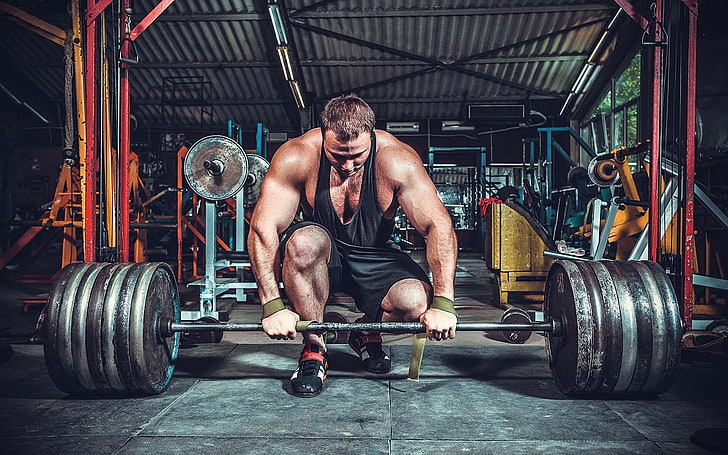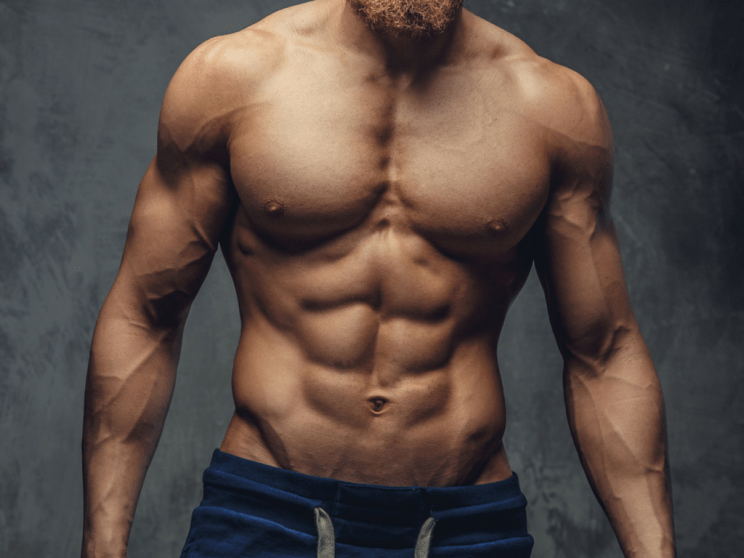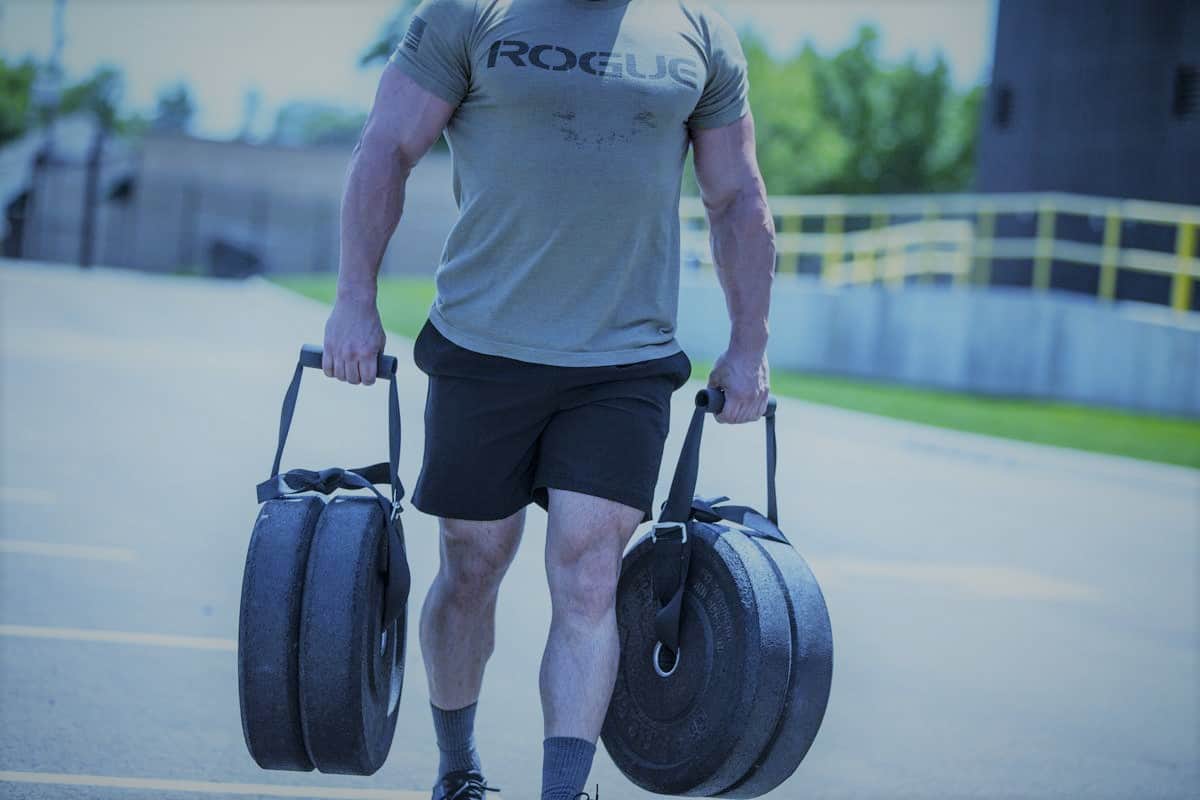Let’s get the obvious part out of the way: hell yeah, you can get ripped while powerlifting. If your definition of ripped is that of the average person, that is. Powerlifters perform best at 12-15% body fat, which is enough to see a six-pack, but not enough to get you a podium finish at a bodybuilding contest. You’ll look awesome at the beach, but you aren’t going to be shredded.
You could get seriously shredded while powerlifting, but you’d also certainly drop some strength gains on the way into the realm of a single-digit body fat percentage. However, if you just want some visible definition, a bicep vein, a nice forearm pump, and a six-pack, all while being strong as hell, then yes, powerlifting is certainly conducive to getting ripped.
We’re Not All Fat, But Some of Us Are
If you’ve only seen a glimpse of what the world
of powerlifting is life, you could be excused for thinking that powerlifters
are generally fat, balding, and out of breath. The reality is that powerlifting
is a sport of relative strength, where you must lift the most weight you can
within your respective weight class.
Because basic science tells us that muscle moves the iron, and not fat, people who are at the elite level of the sport try to minimize their body fat without compromising performance, in order to maximize how much muscle they can pack onto their frame and stay within the top of their respective weight class.
Sure, there are fat powerlifters. The Super Heavy Weights (120kg+) of the realm of powerlifting have reached maximum muscle mass and can get just a touch more of an advantage by packing on extra weight, even if that weight is pure water and fat. You’re also typically stronger on a surplus, and without any weight restrictions above 120kg, you might as well go all out and pack on as much muscle as possible, regardless of how much fat you end up packing on in the process.
It’s important to note that they’re not as fat as you might think – ultrasound studies done on Ray Williams suggest he’s got about 24.3% body fat. He’s certainly obese, but that fat has also helped him cultivate over 130kg of fat-free mass. That’s far more muscle than anyone in the sub-120kg+ categories, as basic arithmetic reveals. Other elite SHWs are likely also extremely muscular under their fat, and some untested humans (like Larry Wheels) walk around with 120kg+ of bodyweight and low body fat.
But while the biggest boys are moving the biggest weight, it’s important to note that the top lifters in the 59kg, 66kg, 74kg, 83kg, 93kg, and 105kg weight classes for powerlifting federations tend to be ripped, and incredibly jacked (meaning very muscular at a low body fat).
They’re definitely not going to get their
IFBB card in typical powerlifting competition condition, and no bodybuilding
coach would tell them to go compete at Olympia the same day they’re headed to a
meet, but to the average person, they’re definitely not walking blobs either.
So, how do you, the average Joe, go about getting ripped while powerlifting? You have to play the long game and remember that body fat is determined in the kitchen and not in the gym.
It’s All About Bodyfat
To get ripped as a powerlifter, you need to reach a certain body fat level while having a sizeable amount of muscle. There are two ways to go about this:
- Either you’re already quite strong and muscular, but you’ve also got a substantial body fat; or,
- You’re lean and small but want to be lean and big.
The first example has to cut their calories
down to a level where they’re losing enough weight each week to work their way
towards the bodyfat they want without eating into their muscles (which is only
something you really have to worry about when aiming for a single-digit body
fat percentage, more on that later), while the second example needs to go on a
modest caloric surplus and simply continue to train for strength and size without
packing on too much unnecessary fat.
To get ripped, you need to hit a certain body fat percentage. That body fat percentage depends on your definition of the word “ripped”. If you’re strong and fat, or skinny and fat, then the first thing you should do is just keep on making progress in your training while staying on a caloric deficit. Aim to lose 0.7% of your current total bodyweight per week.
That is a relatively safe weekly goal that
avoids diets so drastic that they eat into your strength. You won’t gain strength
or muscle as fast as you would in a surplus, but that doesn’t matter for the
long-term, especially if you’re still relatively new to this.
If you’re already lean, but not big enough,
just keep eating at a modest surplus. There’s no real way to accurately tell
how many calories you’re truly burning in a day, so your best bet is to pick a
calculator online to get a rough estimate, and add 250 calories at a time until
you start to gain about a pound every two weeks. That’s 100-200g a week.
Measure your waist and try to grow no more than a quarter-inch a month. Know that you’ll likely gain around 2-3kg of muscle per year after your newbie gains phase is over, so set yourself a goal size based on your current frame and weight, and estimate however long you’ll have to slowly bulk to get there.
Diets Don’t Work and Restrictions Don’t
Matter
One thing that’ll definitely mess you up if
you’re trying to get ripped is a yoyo diet. I can understand why some people who
desperately want to reach a certain clothing size will starve themselves and go
through ridiculous cleanses in the name of the almighty scale, but I’ll never
fathom why a recreational lifter would ever consider going through a risky
diet.
You’re going to lose muscle and strength! If you remotely care about maintaining your total or even putting up a greater squat, bench, or deadlift, you need to lose weight at a rate that’s realistic and manageable. You should get ripped while powerlifting but at a healthy rate.
And before you ask, no, you won’t lose
weight faster if you’re at the same caloric deficit in a keto diet, or a vegan
diet, or a low-fat diet, or any restrictive diet. Don’t just eat nothing but
meat, and don’t just cut a food group out for no good reason. Vegans have
ethical reasons for being vegan, which is perfectly fine, and there are plenty
of vegan options and supplements to help you stay vegan and maximize your athletic
performance. But if you just want to cut weight, eat a balanced diet with a caloric
deficit.
Not Everyone Can Get Shredded
Will you get shredded? No. At least, I can’t say that you will. This is an important part of losing weight – a lot of it is genetic. If you’re 200lbs overweight and have never been lean in your life, then it’s very unlikely that you’ll work your way down into getting ripped. It’s possible but unlikely. You can still aim to cut down to 18-20% body fat and look great. Seriously, you’ll look much better. You’ll have a little bit of a belly but nothing major, and you’ll have great arms and legs.
If you’ve always been pretty lean without effort, sure, you can probably get shredded. It’s not going to help you if you’re a powerlifter. Powerlifters need to maintain at least around 12% body fat – dropping below that magic number begins to cause strength deficits in most people.
Again, I say most. Individuals will find that the exact percentage will depend from one person to another. Dropping under that number will make you even leaner and move away from ripped into shredded – but you will get weaker, too. Your body needs a certain level of body fat to efficiently produce the hormones that keep you going, and not begin to kick things down a notch to preserve energy.
Again, I need to stress that you’ll still
likely be able to reach a point where you’ll have great muscle definition and
you’ll look better than most of the population. Everyone can get a great gym body.
It might not be poster-worthy, but it’ll be hotter than when you first signed
up at your local gym.
Weight Classes and Muscular Potential
To set realistic goals, you need to understand just how big you’re likely to get – and why getting muscular is so important in powerlifting. To put it simply, we’re all born with genetic potential. Whether that genetic potential is reached depends on environmental factors.
But there are limits put in place upon
conception. And there’s nothing any of us can do about those limits. Some of
them can be broken with tactics that will likely make you drop out of any drug-tested
federation, but many of them cannot.
The three limitations that are immovable
and genetically determined are your bones, your leverages, and your muscle insertions.
- The thicker and longer your bones, the more muscle your body can grow on them. Taller, wider people with bigger wrists and ankles and shoulders will have the bones to pack on more muscle than the hard gainer with a pre-serum Steve Rogers bone structure.
- Limb length and torso length also helps makes certain lifts harder or easier. Shorter arms and shorter thighs make for easier bench presses and squats. Longer arms help in the deadlift. And finally, where your muscles attach to the bone helps with force output.
- We all have the same muscles, but where they attach to the bone determines how hard they can contract at their peak, and how much force they output when fully contracted. Someone with great insertions (shorter, thicker muscles, attaching higher on the bone) will contract more powerfully.
These three limitations are unworkable. Everyone gets a dice roll. Be glad you have the means to squat, bench, and deadlift to begin with, and aren’t paraplegic or struggling with palsy for every day of your life.
And don’t ever blame your genes for poor mechanics, small muscles, or general weakness. Everyone can get massively strong in their own way. Accepting you likely aren’t cut out for the elite level is part of cultivating mental strength.
What is workable, however, is your technique (the efficiency with which you lift based on your fat-free mass) and how close you get to your maximum potential fat-free mass (which is largely, but not completely, based on your frame).
Rather than get into exactly how much muscle you can pack on and how much weight you can statistically lift (which I think is useless information, and should be explored by just lifting more and training smarter), I’ll link to an excellent guide by Greg Nuckols on all the currently-available ways we’ve been trying to calculate people’s drug-free muscular potential.
Another interesting powerlifting-specific tidbit is on weight classes. Your best weight class is the weight class your frame lets you reach. That’s it. Get as big and powerful as you potentially can and stay there. Get ripped while powerlifting.
Compete as soon as you are able to – competing helps propel you forward, gives you goals, puts you in touch with coaches, and introduces you to a community of people with totals that are far bigger than your own, with a pool of experience that far outshines what yours might be in that given moment.
Avoid the Dirty Bulk
The old adage among bros everywhere is that
the key to getting big is to get really, really big (GOMAD, massive surpluses,
cultivating “mass” through a dirty bulk) and then to cut until you reach the
point you want, and to then repeat the cycle ad nauseam.
There are a few problems with the bulking
and cutting cycle. The first problem is that it wastes time. While you can preserve
and increase strength on a cut, you’ll get stronger faster on a surplus. It
takes time to cut weight naturally, time where you won’t be progressing as fast
as you could be progressing if you had been sustaining a much more reasonable “clean”
bulk.
The second is that it’s unhealthy. Getting really fat is just not good for your heart or any of your other organs and joints, and it affects your hormones as well.
This can affect the rate at which you’re building muscle because at a certain body fat percentage, your testosterone levels begin to drop significantly and you’ll be wasting time trying to attain more mass and gain more weight, while the weight you’re gaining will be less and less significant to your end goals because more and more of it is fat, and less and less of it is muscle.
Without anabolic steroids or the wonders of
late puberty, there’s a fixed amount of lean muscle that the body can pack on per
year. Untrained individuals pack on muscle the fastest, alongside water, sugar,
and fat. You can gain 10kg of “muscle” in your first year, but it’s probably
closer to 5kg of muscle, and a lot of water and muscle glycogen.
Whatever you gained in your first year will take much longer to gain afterward, with diminishing returns until you reach peak muscularity, which depends on your frame and genes (again, check out that article about muscular potential).
Powerlifting Definitely Builds Muscle
Powerlifting builds muscle. You’re stressing the muscle with repetitive, progressively overloading training stimulus, forcing it to grow and making you a bigger and better lifter. There are countless studies of high intensity, even low volume resistance training introducing muscle growth in subjects, as well as strength gains.
The strongest guy in the room isn’t the guy
with the best technique, but the best technique and the most muscle. You
want both. You need both.
If all you want is to be ripped while powerlifting, maybe just stick to bodybuilding. Bodybuilders perform the big three and a variety of other exercises, but they don’t care about having the biggest bench, squat, or deadlift in the country.
But if you’re a powerlifter who wants to know if you can be ripped and still compete, then hell yes, you can get ripped and still be a great powerlifter. In fact, I’d argue most successfully powerlifters in their weight class are ripped. Getting ripped while powerlifting is almost a necessity to be competitive unless you’re crazy massive.
The exceptions are those stuck at an awkward place on the scale where their maximum ripped weight is just barely above the limit of a weight class, so they have to cut water and carbs before a weigh-in or let themselves go a bit to fill out the new class, potentially to 18% body fat or so.
Getting Ripped is Part of Powerlifting
I’ll stress it again: this is a sport with
weight classes. If you’re 177cm/5’10 and 83kg while your competition is 167cm/5’6
and 83kg, they’ve likely got more muscle (since they’re packing a smaller
frame).
This means they’ve got a better chance of
moving more weight if both of you are evenly matched in terms of technique and
leverages. Either way, you’re at a mechanical disadvantage because you’re working
with less muscle mass.
So, if you’re not already ripped while powerlifting, get on it, friend. Let me know in the comments how your body comp journey is going.
Ready to Take Your Fitness to the Next Level?
Whether it's power building, recovery, or nutrition, our experts are here to help you succeed. Contact us today to get personalized advice, support, and a tailored plan that fits your goals.
Let’s build the strength and body you deserve!
CONTACT US NOW




